STOP Targeting Google: The "Search Experience" Trick That's Quietly Doubling Traffic
“Why are so many visitors bouncing from my website?” This is the question we keep hearing from CMOs and marketing leaders in conversations across public forums, Reddit queries, LinkedIn comments and beyond.
Ranking on the first page used to be the badge of honour for SEO teams, yet bounce rates remain high and conversions are stagnant. We noticed a huge disconnect: many brands still optimise for bots and ignore the human on the other side of the click. Search Experience Optimisation (SEO) is the solution to your website bounce problem.
Instead of chasing keywords, you need to design journeys that align with user intent, delight on-page and persuade action.
In this in‑depth guide, we share the research, tools and frameworks we’ve used to transform search visits into meaningful engagements.
What is Search Experience Optimization (SXO)?
Traditional Search Engine Optimization (SEO) was born in a world where search engines rewarded technical compliance and keyword density.
Over the years, algorithms have evolved to prioritise relevance and satisfaction, integrating user experience signals such as dwell time, bounce rate and core web vitals into ranking factors.
Search Experience Optimization (SXO) is the evolution of SEO. It blends classic search tactics with User Experience (UX) and Conversion Rate Optimisation (CRO) to optimise the entire journey from query to conversion.
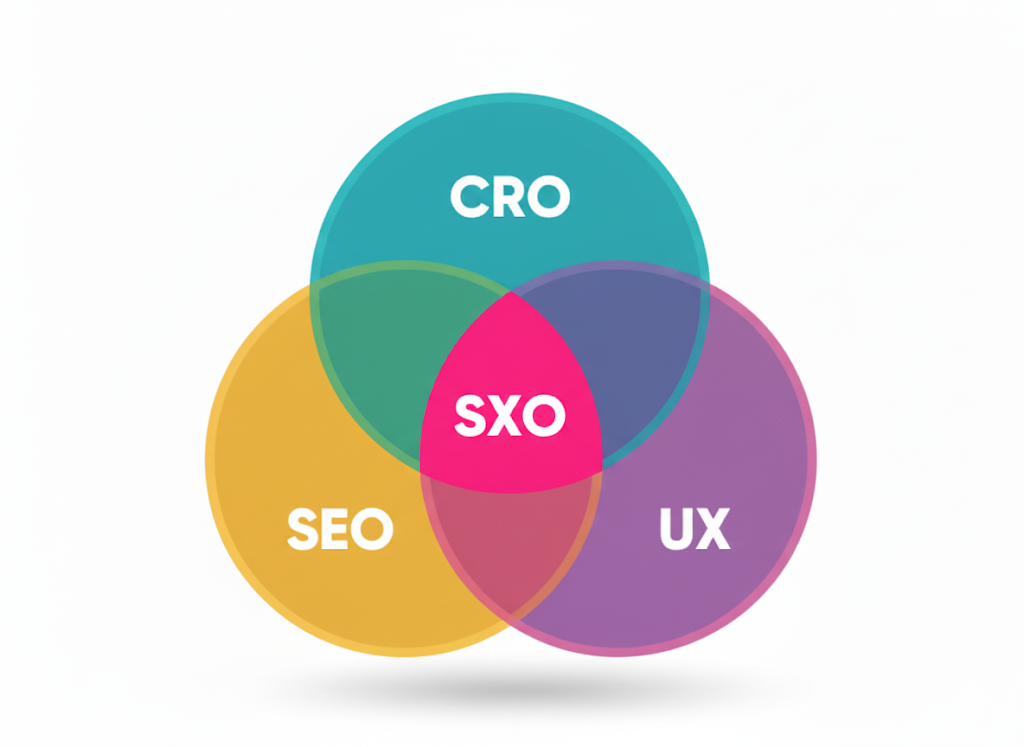
The goal is not merely to attract visitors but to ensure they stay, find value and take action.
SXO emerged because search engines themselves grew smarter. Early algorithm updates like Google’s Panda and Hummingbird penalised thin content and rewarded semantic relevance.
More recently, AI-driven models, such as Google’s Search Generative Experience (SGE), like AI Overview and AI mode, provide zero-click answers in just a blink of an eye.
When engines can answer basic queries without clicks, the bar for earning a visit is much higher. SXO ensures that when a user clicks, they are greeted with pages that understand their context, load instantly, and guide them toward a satisfying outcome.
The distinction between SEO and SXO can be summarised as -
- SEO focuses on ranking factors, including keywords, backlinks, meta tags, and crawlability. SXO adds human factors like intent alignment, page speed, micro‑interactions and persuasion.
- While SEO’s scoreboard is keyword rankings, SXO’s scoreboard is conversion and customer satisfaction. Both remain vital, but SXO broadens the lens to include experience and outcome.
When we analyse SXO, we see three pillars:
- SEO (Visibility) – Start by doing comprehensive keyword research, creating relevant content and ensuring technical health so that search engines surface your pages. SXO extends this by aligning keywords with user intent instead of vanity volume. Keywords become questions to be answered.
- UX (Usability) – Then build pages that load quickly, offer a smooth experience on mobile and desktop, and guide users seamlessly through tasks. Search engines now reward sites with fast loading times and accessible interfaces; Google’s core web vitals and helpful content guidelines emphasise this.
- CRO (Conversion) – At last, persuade visitors to act, through relevant calls‑to‑action, clear value propositions and frictionless forms or checkout.
Even slight delays hurt revenue; a one-second delay in page load can reduce conversions by 7-20%. B2B sites that load in one second convert at rates 3–5 times higher than those loading in 5–10 seconds.
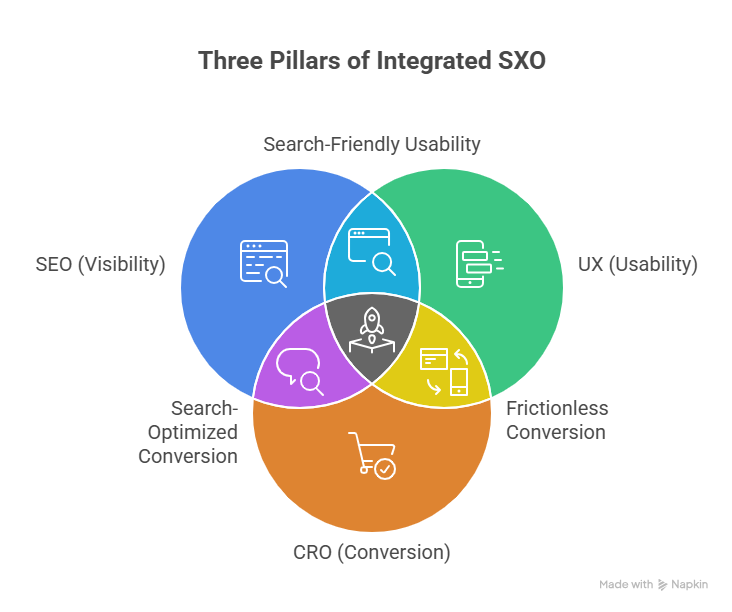
In short, SXO changes the conversation from “how do we rank?” to “how do we serve our searchers better than anyone else?”
We adopt a mindset of empathy and curiosity: who is searching, why are they searching, and what does a perfect experience look like for them?
We optimise every touchpoint, from SERP snippet to confirmation page, to deliver value and drive revenue.
How does SXO work on your website: Explained with iPhone 17 example
User intent sits at the heart of SXO. Without a clear understanding of what searchers want, we risk serving mismatched content or sending visitors down confusing paths.
We analysed the keyword “iPhone 17 price in India” using Ahrefs’ Keywords Explorer to demonstrate how we uncover intent.
In the Matching Terms section, we explored the top-ranking pages and an intent chart that grouped searchers by their micro‑intent.
We begin by using Ahrefs’ Keywords Explorer and exploring the Matching Terms section.
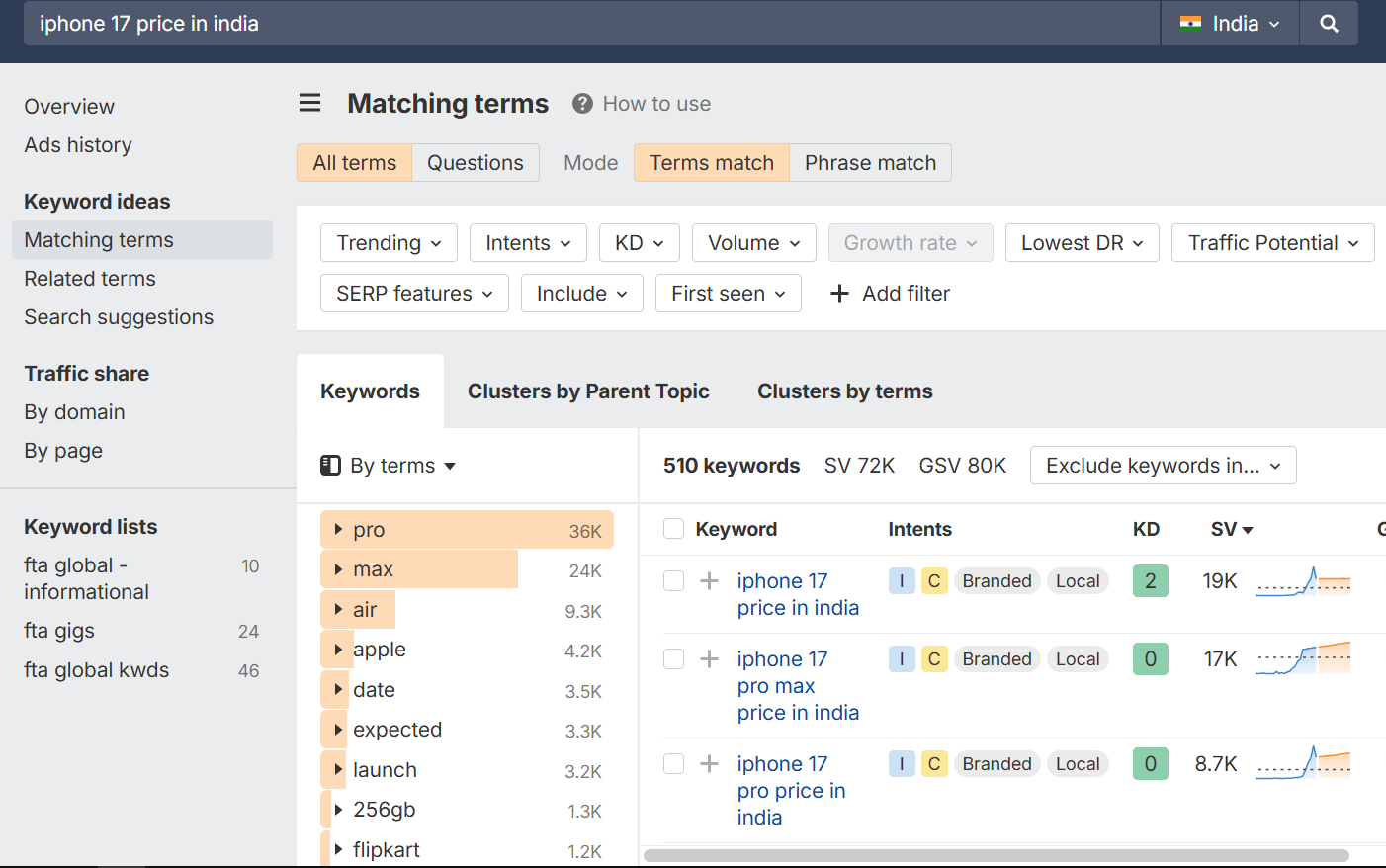
This process of finding the user’s intent provides a clear understanding of why people are looking for your product or service :
- 29% of searchers simply want to check the price of the iPhone 17 in India.
- 27% are interested in features, colours and specifications—essentially researching before committing.
- 24% intend to buy an iPhone 17 directly.
- 13 % want to compare prices across countries or check availability.
- 6 % seek to read or watch product reviews.
We checked the SERP dropdown in Ahrefs for “iPhone 17 price in India” and used Identify Intents to see if people wanted price, specs, comparisons, reviews, or to buy, helping us map content to each stage.
Before diving deeper, it helps to understand the broader meaning of search intent. Let’s classify queries into four main buckets as laid out by Google:
- Informational Intent – the user seeks to learn about a topic, e.g., “iPhone 17 specs” or “how to reset iPhone 17”. These queries require educational content, guides or FAQs.
- Navigational Intent – the user wants to reach a specific site or page, e.g., “Apple official store” or “Myntra login”. Navigation queries emphasise brand recognition and clear site architecture.
- Commercial/investigational Intent – the user is comparing options or researching before purchase, e.g., “iPhone 17 vs Samsung S24” or “best smartphone under ₹80,000”. Here, you need comparison tables, reviews and feature breakdowns.
- Transactional Intent – the user intends to complete a purchase or action, e.g., “buy iPhone 17” or “iPhone 17 exchange offer”. These pages demand transparent pricing, availability, payment and shipping information.
Within each bucket, there are micro‑intents unique to the product or service. For our iPhone example, we uncovered five micro‑intents:
- Price Checking
- Feature Research
- Buying
- Comparison across Markets
- Seeking Reviews
Recognising micro‑intents allows us to craft targeted content sections, spec sheets for researchers, price alerts for bargain hunters, and review roundups for sceptics.
Some visitors are still learning, others are ready to make a purchase, and a small cohort wants to read reviews.
Recognising this spectrum enables us to design a journey that meets each group where they are.
For instance, a marketing firm’s product page should display pricing prominently, include detailed specifications, provide comparisons and embed customer reviews or video testimonials.
We visualised this distribution using a bar chart to highlight the relative importance of each intent and a funnel diagram to represent how the intent narrows as users get closer to purchase.
Distribution of micro‑intents
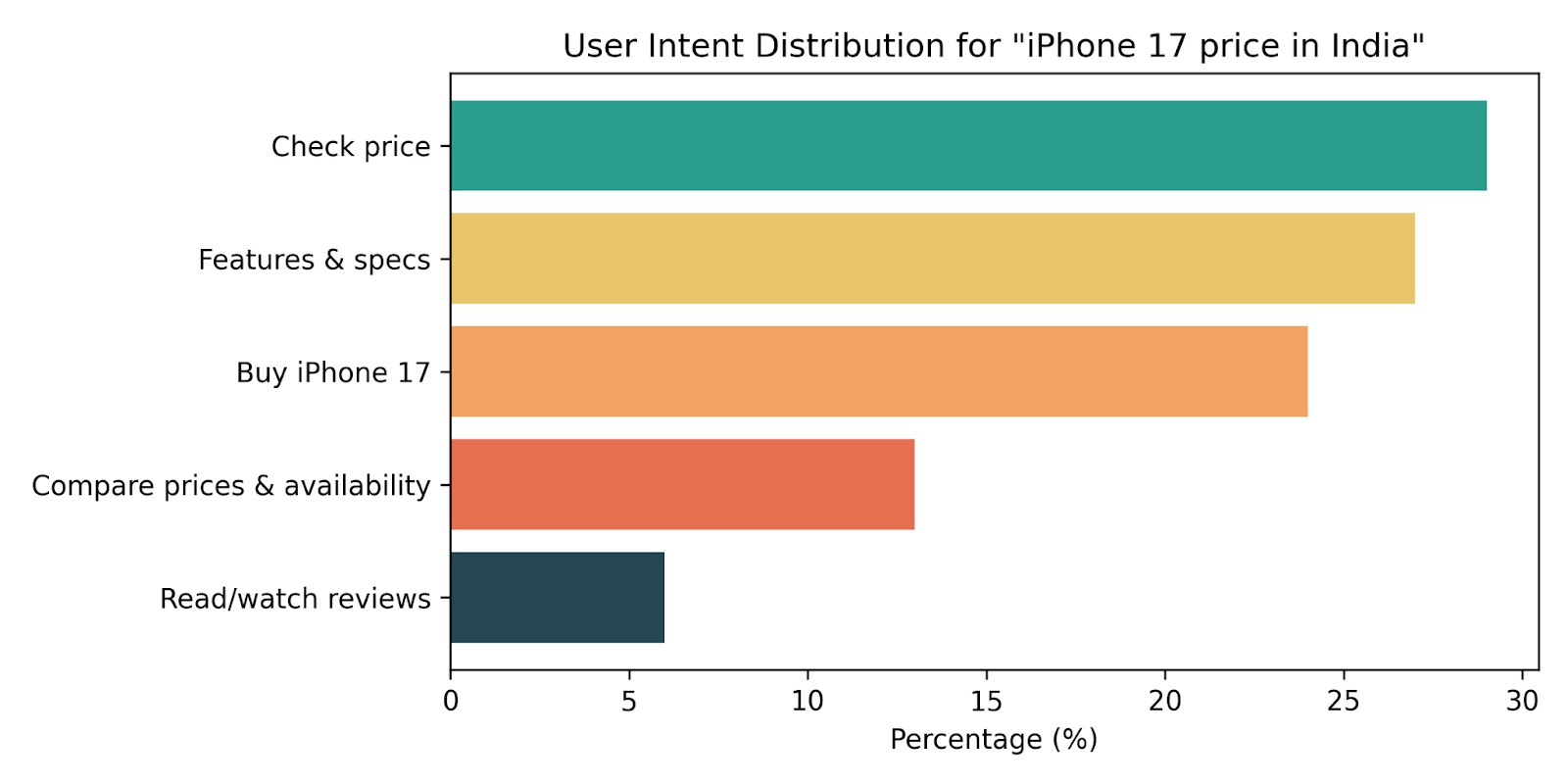
The horizontal bars indicate what the user is looking for when searching for iPhone 17. Designers can use this insight to prioritise pricing tables and specification sheets.
Funnel of user intent
By arranging the intents as a funnel, we emphasise that not all searchers are ready for the next step.
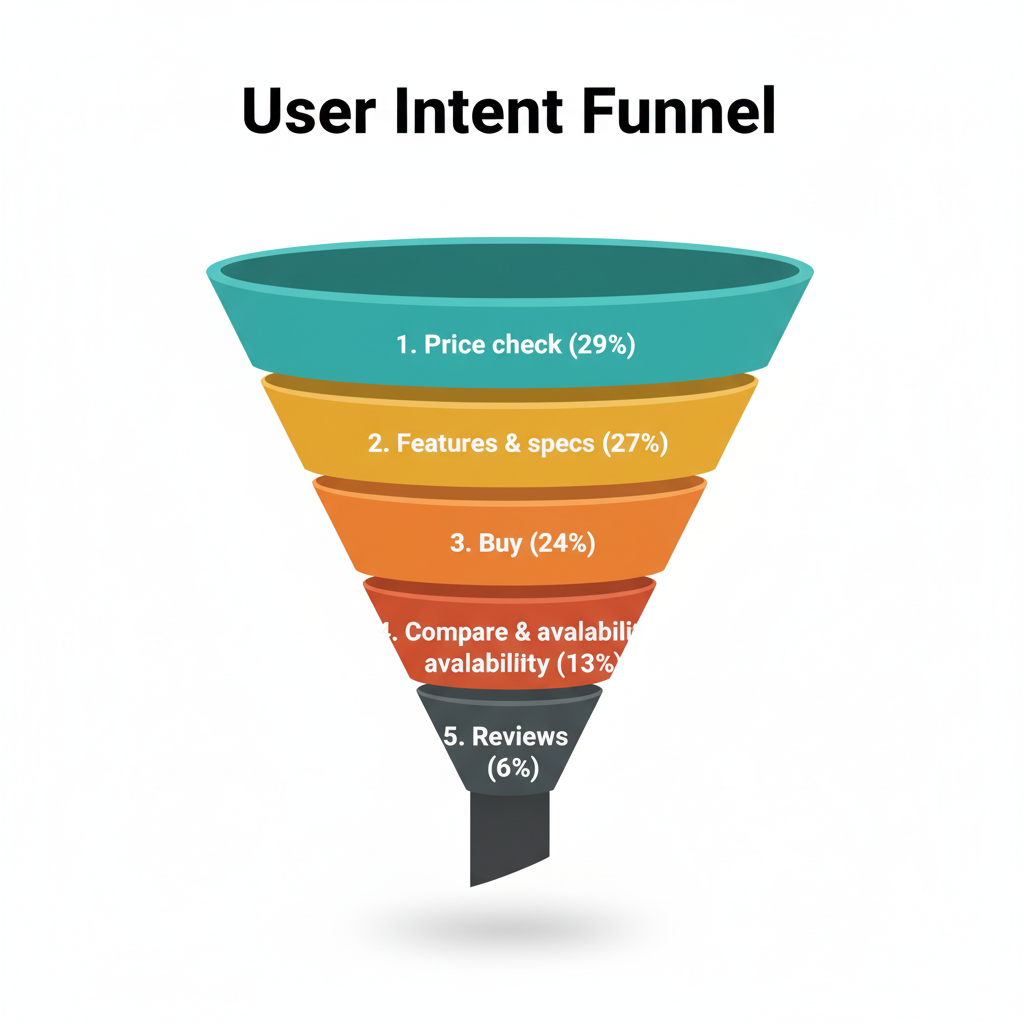
SXO practitioners should design content and navigation to gently guide users downward, delivering information, building trust and encouraging action at the right moment.
Components of SXO: aligning visibility, usability and conversion
SXO requires orchestrating multiple disciplines. We break it down into three complementary components and share the techniques that have yielded results across various campaigns.
Aligning SEO with user intent
The traditional SEO playbook emphasises keyword volume and ranking. SXO pushes us to understand why users search and deliver content that satisfies that intent.
We approach keyword research with a dual lens: what are the broad terms (e.g., “iPhone 17”) and what are the supporting questions (“price in India”, “blue vs black”) that reveal context?
Tools like Ahrefs’ Keywords Explorer and Semrush’s Keyword Magic Tool help us discover these questions and their relative volumes.
Once identified, we organise content into clusters. Pages targeting research intent contain in-depth features, comparisons, and FAQs, while transactional pages present price, availability, and purchase options clearly.
Beyond organising content, SXO‑oriented SEO considers long‑tail queries and emerging platforms. Search behaviour is fragmenting across voice assistants, social search and chatbots.
Optimising for conversational phrases like “Hey Siri, what colours does the iPhone 17 come in?” requires natural language content and FAQ markup.
You should prepare for zero‑click searches, where searchers get answers directly on the results page. By using featured snippets and structured data, we can still drive brand impressions and capture clicks from those who want more depth in their search.
Optimising UX and core web vitals
User experience is no longer a “nice‑to‑have”; it directly influences rankings and conversions. Google’s algorithm updates prioritise sites that load quickly, are mobile-friendly and provide seamless navigation.
Page speed is especially critical. Studies show that B2B websites loading in one second convert 3x as many visitors as those loading in five seconds and 5x as many as those loading in ten seconds. Here is a correlation chart to help you understand it better:
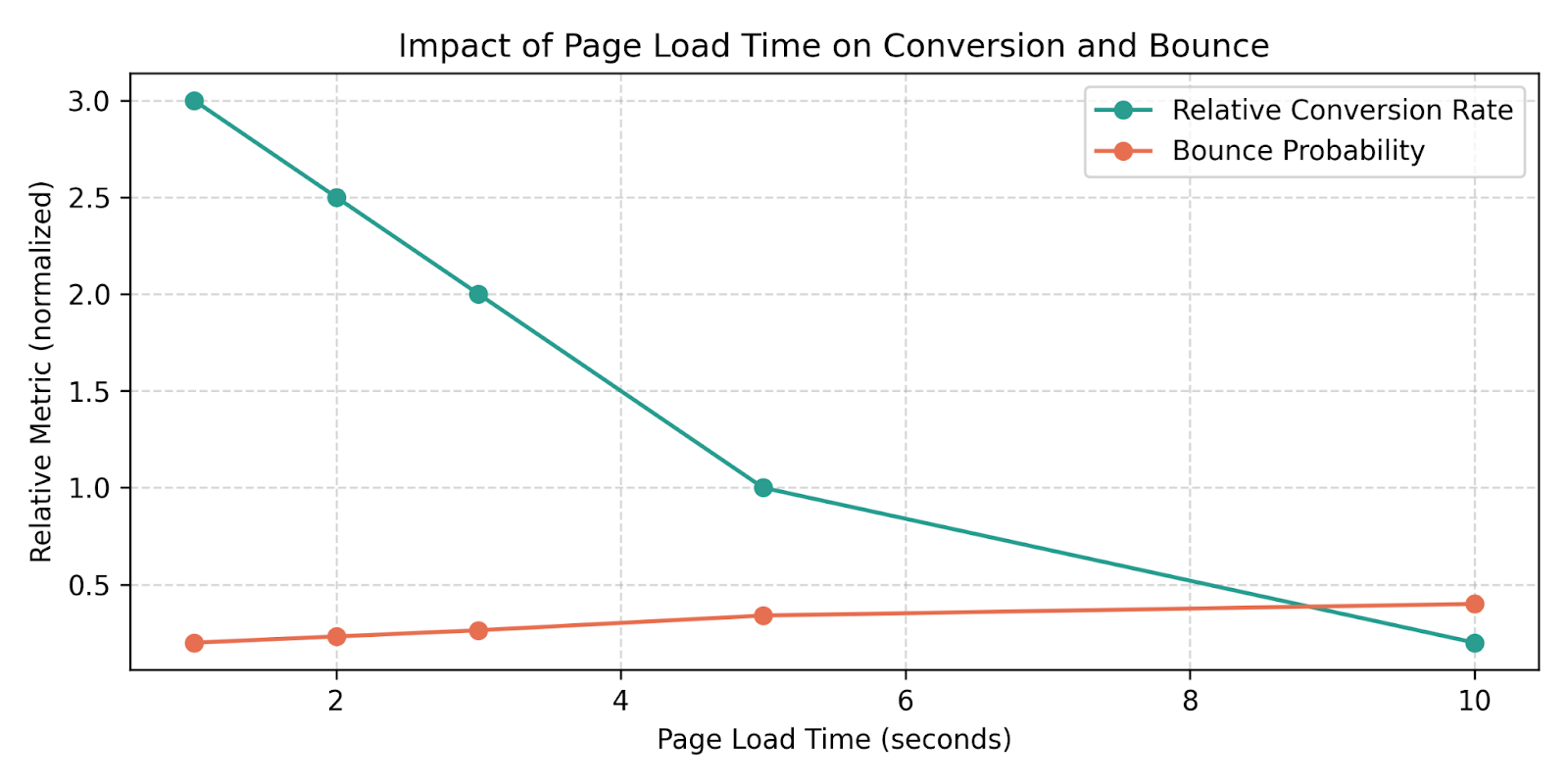
To deliver a great user experience, SXO experts must:
- Optimise images and media using modern formats (WebP), compression and lazy loading.
- Implement caching and CDNs to reduce server response times, particularly for India’s mobile‑first audience.
- Design for mobile‑first by placing navigation, buttons and call‑to‑action within thumb reach. With over 70% of India’s internet traffic coming from mobile devices, failing to optimise for handhelds results in lost revenue.
- Use clear hierarchy and white space so visitors can scan quickly. Each section should deliver one main idea within two lines or less, matching the reading habits of busy professionals.
Converting visitors through CRO
Once visitors find and enjoy your content, you must persuade them to act. Conversion Rate Optimisation (CRO) is the discipline of turning user interest into action.
In order to complete the intended action, which is buying a product or a service, brands need to focus on the following factors:
- Compelling call‑to‑action (CTA): Buttons should be descriptive (“Buy iPhone 17 now”, “Compare colours”) and appear at natural decision points. Contrasting colours help them stand out without being intrusive.
- Simplified forms and checkout: Reducing the number of fields increases completion rates; enabling guest checkout or social logins reduces friction.
- A/B testing: Experiment with headlines, images, button placement and messaging to learn what resonates. Continual testing and iteration are essential.
- Personalisation: Delivering content tailored to different segments increases relevance.
For example, visitors in the “learn” stage might see a specification comparison table, while those closer to purchase see financing options and a store locator.
Myntra’s personalised retargeting emails blend SEO, UX and CRO to deliver exceptional search experiences.
The Indian fashion marketplace Myntra excels at personalised email marketing. SXO extends beyond web pages; it encompasses every touchpoint triggered by a search. When a visitor creates an account or adds items to a cart, Myntra doesn’t bombard them with generic promotions.
Instead, they send tailored reminders about the items left behind, suggest similar products and share festive deals. Their email subject lines are warm and encouraging, and their messages include direct links to the shopping cart. This approach keeps potential buyers engaged and nudges them toward conversion without being intrusive.
While this tactic sits under “email marketing”, it is integral to SXO because it leverages the data captured during the search journey to deliver relevant follow‑ups. The result is improved conversion rates and loyalty.
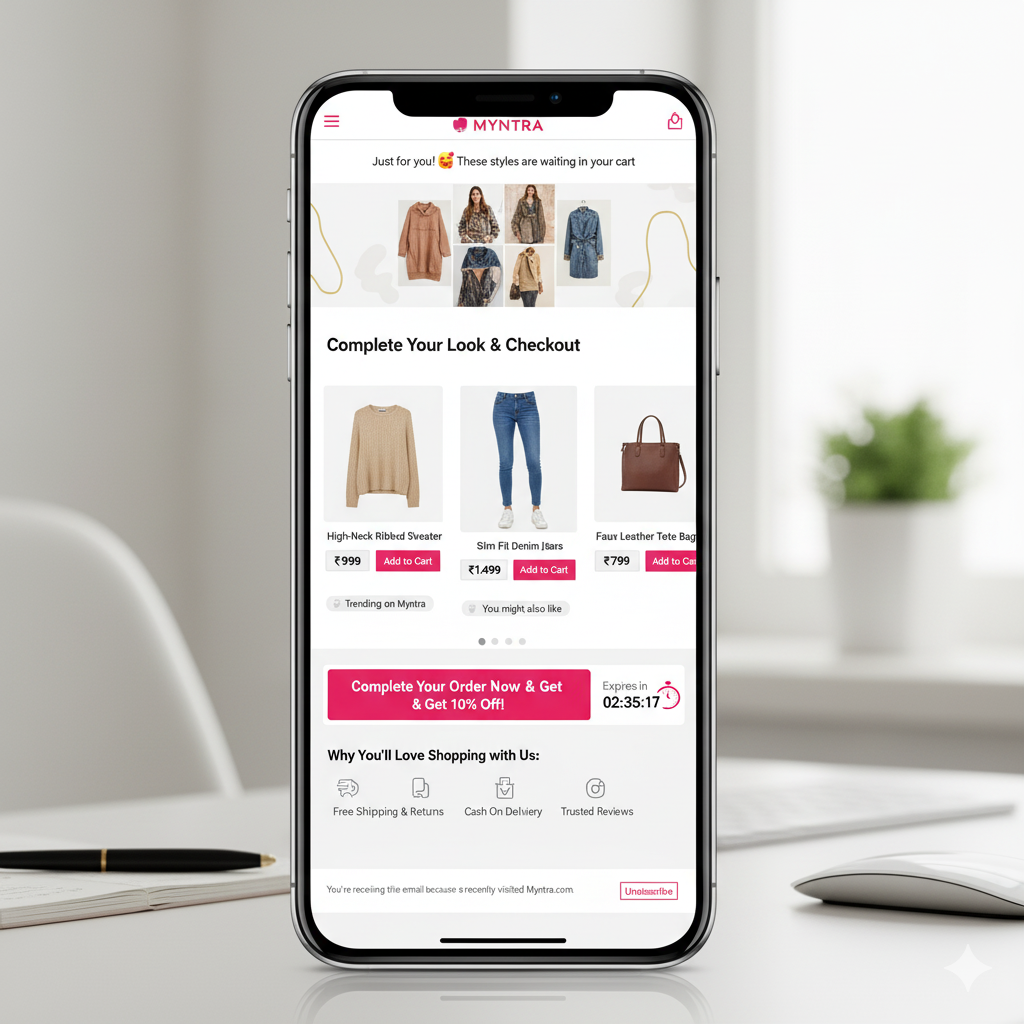
An example of how Myntra integrates SXO within its app to offer a seamless experience to its customers.
Grammarly’s educational content and free tools
Another brand that embodies SXO principles is Grammarly, the online writing assistant. Grammarly drives huge volumes of organic traffic by offering concise links to a suite of free tools: a plagiarism checker, punctuation checker, and grammar checker.
The company maintains an up‑to‑date blog covering basic to advanced grammar concepts, packed with relevant keywords and examples. Other websites frequently reference this content, boosting its authority and backlink profile. Once visitors have enjoyed the free tools and trustworthy articles,
Grammarly invites them to upgrade to premium services. This progression from free value to paid subscription exemplifies SXO: high-quality content attracts searchers, a user-friendly site retains them, and persuasive calls-to-action convert them.
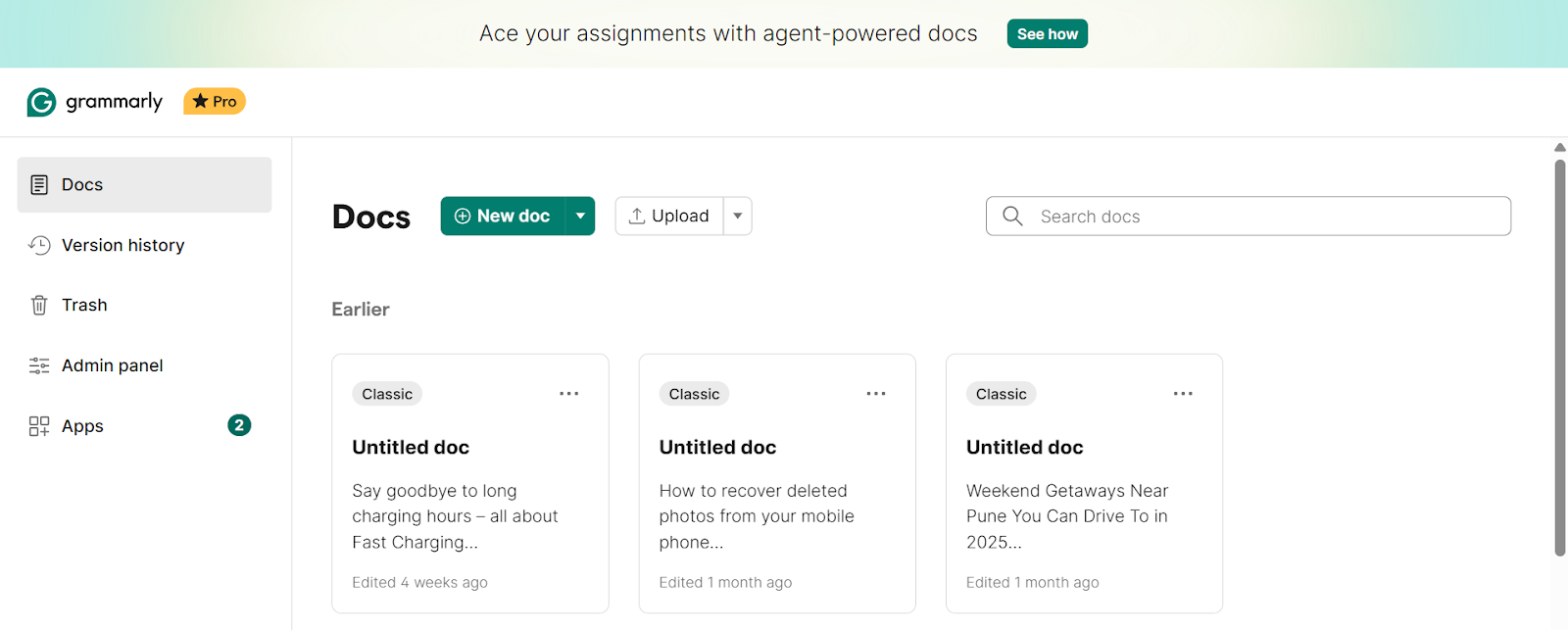
Grammarly provides a personalised experience according to a user’s writing preferences, guiding them to write better
Building your own SXO strategy
If you wish to improve your users’ experience on your website and reduce the bounce rate, keep these pointers in mind while strategising your SXO strategy:
- Research user intent: Use tools like Ahrefs, Semrush or HubSpot’s Topic Clusters to discover search queries and group them by intent (informational, navigational, commercial, transactional). When we analysed “iPhone 17 price in India”, we segmented searchers into five micro‑intent groups and designed corresponding content sections.
- Map the journey: Create a customer journey map linking search queries to pages, CTAs and follow‑ups. Ensure there’s a logical path from question to solution.
For price checkers, the path might be: SERP → pricing table → comparison guide → buy now; for researchers, it could be: SERP → features page → review videos → subscribe for updates.
- Optimise technical performance: Implement page speed best practices (compression, caching, CDN), mobile‑first design and accessibility. Evaluate Core Web Vitals regularly.
- Craft persuasive content: Write concise, engaging copy using active voice. Break text into short paragraphs and bullet lists to facilitate scanning. Use data, diagrams and real‑world examples to build credibility. Include internal links to guide visitors deeper into your site.
- Test and iterate: Use analytics to monitor bounce rates, dwell time, click‑through rates and conversion rates. Conduct A/B tests on headlines, layouts and CTAs. Continually refine based on user behaviour. As YellowHEAD emphasises, SXO is an iterative process.
- Extend beyond search: Align email marketing, remarketing ads and customer support with the intent discovered in search. Myntra’s personalised emails and Apple’s cross‑device integration illustrate how SXO continues after a visitor leaves your site.
- Measure what matters the most: Establish key performance indicators (KPIs) beyond rankings, such as bounce rate, average session duration, scroll depth, conversion rate and customer lifetime value. Use heatmaps and session recordings to identify where users encounter difficulties. If your bounce rate drops after improving page speed or restructuring a menu, you’re moving in the right direction.
- Integrate emerging channels:
- Voice search, smart speakers and chatbots are reshaping how people discover information.
- Adapt your content to natural language and concise answers. Optimise for local search and “near me” queries if you have physical outlets.
- Consider how generative AI snippets (SGE) might summarise your content.
- Ensure your pages provide enough context and value to compel users to click through.
- Create a feedback loop: Encourage reviews and user feedback across your product pages, social media and email follow‑ups. Real comments not only build credibility but also reveal pain points. Use this qualitative data alongside analytics to prioritise improvements.
The future belongs to user experiences and mapping those journeys
Search Experience Optimisation is a strategic shift that recognises searchers as humans and prepares us for the future of AI‑driven search.
Generative search results and voice assistants will provide instant answers to basic queries. What will compel a person to click on your link or ask their assistant to open your site?
As marketing leaders in a mobile‑first India, the stakes are higher than ever. Attention spans are short, competition is fierce, and technology is evolving at breakneck speed.
The next time you review your marketing performance, ask yourself: Are we optimising only for rankings, or are we optimising the entire experience?
Your answer will determine whether your future visitors bounce after two seconds or become advocates who tell their friends and colleagues about you. The path you choose could define the success of your brand in the next era of search.
Do you want more traffic?

How Should You Structure Information in RAG so Retrieval Never Fails?

How Do Indexing Metadata and Structure Make LLM Search Work?
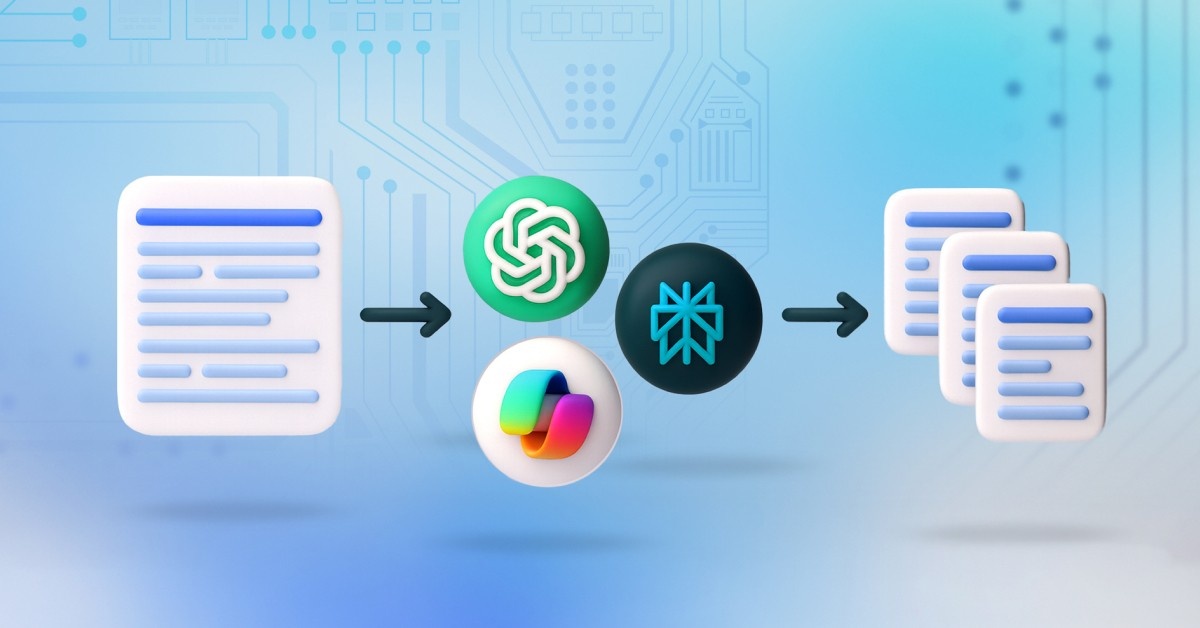
A Complete Guide to Chunk Optimisation and Index Planning in B2B Marketing










